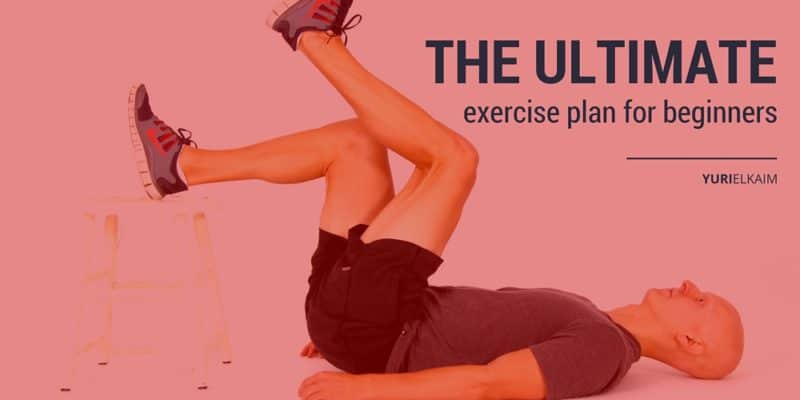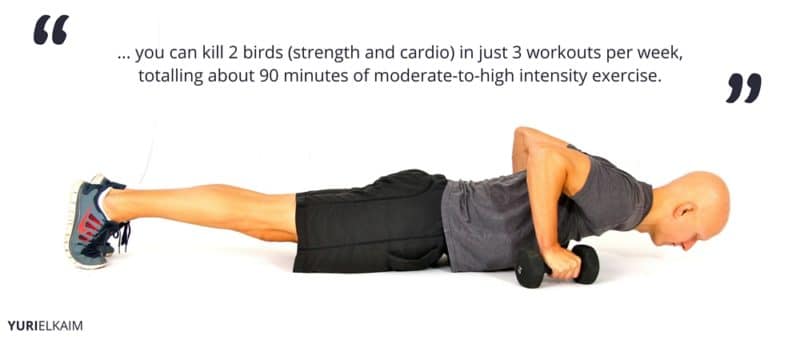
In this article
You already know adding exercise to your daily routine is a vital part of looking and feeling your best. But what is the best way to begin? Is there an ideal exercise plan for beginners? Well, I’ll show you in this article.
If you’re admittedly unfit, can’t remember the last time you worked out, or consider yourself a complete exercise “newbie”, then this information is specifically for you.
Let’s start by walking through a few basic principles, then we’ll get you a free Fat Blaster Workout designed to help you burn fat, lose weight, and get the healthiest body of your life.
Sound good?
How Much Do I Have to Workout?
If you’ve asked yourself this question, then here’s a simple answer:
The World Health Organization recently released an new report called the “Global Recommendations on Physical Activity and Health.” These general recommendations come from global leaders in medicine and science. They’re a good baseline to keep in mind for beginners.
The new recommendations break down like this:
- Adults aged 18-64 should do at least 150 minutes of moderate-intensity aerobic activity per week
- Aerobic activity should be performed in bouts of at least 10 minutes in duration
- Muscle-strengthening activities should be done, involving major muscle groups 2 or more days per week
If you landed here looking for the ultimate exercise plan for beginners, then these recommendations are pretty good “starter” recommendations.
Personally, I think (and have seen anecdotally and in a lot of the research) that you can kill 2 birds (strength and cardio) in just 3 workouts per week, totalling about 90 minutes of moderate-to-high intensity exercise.
However, let’s keep things super gentle and easy to start.
Basically, each adult should ideally be moving their body for about 30 minutes of cardiorespiratory activity per day (think: it makes you breathe hard) for at least 5 days a week.
Alternately, you can work out more on fewer days, as long as you’re aiming for a general 90-150 minutes of total exercise time per week. Again, don’t fuss about the actual number. In the long run, the intensity of exercise (especially cardio) will be a more important factor.
Remember, if you add vigorous-intensity exercise, like interval training for example, you don’t have to spend that doing a full 150 minutes each week. In fact, intense workouts take about 1/3 the time for the even greater benefits.
Vigorous-intensity exercise also comes with a boost to longevity too. For example, data shows that those who engage in intense exercise regularly have longevity of about 5.5 years longer than the average person. (1)
That’s not to say doing lots of vigorous-intensity exercise is the way. It’s about using it intelligently. 3-4 times per week is more than enough.
Also bear in mind that your exercise plan should evolve as you do. For instance, when I was playing pro soccer I was training like an animal. Nowadays, my training is much different… with workouts focusing on big lifts to build strength rather than high-intensity metabolic workouts that leave me lying on the floor after I’m done.
Regardless of how you exercise, one thing must remain the same: you must challenge your body to get stronger and fitter. That’s why I don’t consider walking anything more than a basic activity that we should all be doing every day—kind of like breathing. Whatever you choose to do, just as with diets, the best workout is always the one you do consistently.
Now, even though you want to do something you’ll enjoy and do consistently, please… please… do NOT omit heavy resistance training. This is one of the biggest mistakes I see too many women (yes, especially women) make. Listen – you need to strengthen your muscles if you want to be strong and have a fast metabolism that burns through fat 24/7. You cannot stay lean for life if you do not incorporate strength training into your plan.
[Related: 6 Metabolism Facts You Probably Don’t Know… But Should]
The old saying “use it or lose it” holds true here—muscle mass naturally fades over time if it’s not strengthened. To prevent the loss of muscle and strength, you should be adding minimum of at least 2 weekly bouts of resistance training that target all the body’s major muscle groups.
To save you time and give you even better results, I recommend doing workouts that are based on functional training exercises, where you train movements, not muscles.
Keep in mind, this doesn’t have to mean going to the gym. Bodyweight exercises can be done at home, and can be done in the time you’d take to get in the car, drive to the gym, and walk through the front doors.
To give you a taste for what I mean, here are a few of my older YouTube videos that walk you through some good beginner workouts…
Bodyweight Workout for Beginners
Bodyweight Workout at Home
Quick Tip: Be on the lookout for just a little bit of affirming soreness a day or two after a resistance workout. This is the evidence you’ve used heavy enough weight to cause muscles to adapt. Even if you’re not “lifting”, you’ll still feel a little sore just from bodyweight exercises because your body is not used to those movements or loads. Don’t fret because that soreness will go away after a few workouts.
What’s the Best Exercise Plan for Beginners?
If you’re on the hunt for the best beginner workout because you’re just getting started with a more active lifestyle, the above recommendations are a great place to begin. They cover the basic needs of adults, helping you stay healthy, keep strong and fight the aging process.
But if you’re looking to surpass these simple health benefits, you’re going to need 1) a goal and 2) a plan targeted to reach that goal.
Step 1: Set a specific fitness goal
Make that goal specific.
Do you want to lose 10 pounds in 20 days? Do you want to drop your body fat to 21%? Do you want to run a marathon in 6 months? Setting a annual or bi-annual fitness goal is a great way to keep you motivated throughout your life. Specific goals don’t just keep you focused, they help you focus your workout, as well.
I’ve created very specific fitness programs to coach you toward a variety of fitness goals. But if you’re just getting started, there are also some very simple guidelines that will help you get the rewards you’re after. Below are some of the most common goals, with workout guidelines that will help you kickstart the outcome:
Step 2: Focus on the process that will help you reach your goal
Once you’ve set your goal, don’t obsess about the “outcome”. You can’t control it. All you can control are the actions (processes) that will eventually lead to your desired outcome.
Let’s say you want to lose 20 pounds in the next 90 days. That’s your outcome.
Instead, focus your attention on the daily habits that will get you there. For instance, set a schedule in your calendar that has you working out 3 times per week. Have your dinners planned out one week in advance. Start your day with 20 grams of protein.
You could create a simple checklist of daily processes that, over time, will get you to your desired outcome.
It’s like climbing a mountain. You want to reach the summit, but you’re only focused on taking one step at a time and reaching the next altitude’s basecamp. Before you know it, you’ve summitted the mountain.
Step 3: Track your progress
You need to track what you want to manage.
If you want to lose weight, then you’ll want to weigh yourself at least once per week although some research shows that weighing yourself every day is more effective at keeping you on track. (2) If you do this, please do not obsess about the micro fluctuations in your weight.
I’m currently working on building my deadlift to 300 pounds within the next 7 months. I’m currently at 175 pounds. Every time I workout, I track the weight I’m using and the number of reps I complete. In fact, I have all those numbers written down on the whiteboard in my garage gym so that they’re visible at all times.
So measure what you want to manage and keep your numbers visible to you as often as possible so you can see your progress over time.
Moving from Beginner to Seasoned Exerciser
Have you been a workout “beginner” your whole life? Do you start every week with big plans, only to stop a week or month later?
Don’t feel too badly; fair-weather workouts are a very real and common thing.
It’s easy to let fitness get sidelined by a busy life, extreme stress, and other commitments. If you’re serious about your health and your body, then you need to make regular exercise a top priority in your life. After all, being a “start, then stop, and start again” exerciser can have harsh consequences.
A study conducted in 2008 is firm proof that you should think twice before taking a break from your exercise regimens. The study found “the key to staying fit is to remain active year-round, year-after-year, and to avoid seasonal and irregular exercise patterns. Most of all, don’t quit. Failure to do so may be a contributing factor in the nation’s obesity epidemic.” (3)
Using data collected from the National Runners’ Health Study, lead researcher Williams found that the impacts of increasing and decreasing vigorous exercise aren’t the same among all runners. At distances above 20 miles per week in men and 10 miles per week in women, the pounds gained by running less were about the same as the pounds lost by running more. At these exercise levels, the effects of training and quitting training are comparable, and the weight gains and losses associated with changes in exercise levels are probably reversible.
However, Williams found that people who didn’t run as many miles per week face an uphill battle if they want to lose the pounds accumulated during an exercise hiatus. At these less intense levels, an interruption in exercise produces weight gain that is not lost by simply resuming the same exercise regimen.
“At lower mileages, there is asymmetric weight gain and loss from increasing and decreasing exercise, leading to an expected weight gain from an exercise hiatus,” says Williams. “In other words, if you stop exercising, you don’t get to resume where you left off if you want to lose weight.”
Tip 1: Retrain Your Brain
If you are consistently starting and quitting exercise because you dread working out, let’s look at that feeling for a minute. You likely dread workouts because you’ve associated exercise with some level of pain.
[Related: 4 Simple, yet Powerful Ideas to Make Exercise More Fun]
My mom is a classic example. Since I can remember she’s also said she’s going to start exercising. 36 years later I’m still waiting to see that happen. Why? For some reason, she associates exercise with pain. I (and many others) on the other hand associate exercise with growth, strength, energy, and vitality.
It’s a simple mindset shift.
If the short-lived soreness of a workout is keeping you from exercising regularly, then reframe it as something you have to go through on your journey. It’s part of the process and it will subside.
If you don’t like exercising because you were picked last in gym class as a kid, then I’m sorry to say this but you need to get over it already. Are you really going to let some random kids (who are likely struggling themselves now) from the past determine your future? I hope not.
Tip 2: Find Your “Why”
Even people whose jobs are dedicated to fitness have days when they don’t feel like working out. Believe me. We all have those days. Feeling sluggish, tired, and not wanting to move is a result of sitting all day. It’s a pretty common feeling.
One thing that is extremely uncommon though is spending time exercising and then later regretting it. Whether you’re a master in your sport or a fitness newbie, you rarely ever get to the end of a workout or enjoyable activity and think “I shouldn’t have done that.”
Remembering this is the first vital step in making regular movement part of your everyday routine.
Longevity is great and most of us don’t want to die early, however, we can’t end without touching on the best workout benefit of regular exercise—the immediate and instantaneous boost in QUALITY of life.
Every bout of exercise and every extra minute of effort you put out equates to more instant energy, focus, relaxation and many other benefits. It’s not just about benefits to look forward to years down the road. Exercise is the perfect medicine, because it works as soon as it’s applied. You just have to remember your dosing—take it daily!
Dick Van Dyke is one of the most beloved and amazingly youthful celebrities in Hollywood history. He attributes this to a daily routine of activity. When asked about what keeps his motivation high to do this he says, “
I tell people my motives [for exercising] have changed. In my 30s, I exercised to look good; in my 50s, I exercised to stay fit; in my 70s, I exercised to stay ambulatory; and in my 80s, I exercise to avoid assisted living.” (Van Dyke via HuffPo)
There are endless benefits to keeping active as well as increasing the amount of physical activity you engage. However, I can’t tell you “WHY” you should do it. That’s for you to determine. Your “why” will give you the reasons to keep going when you don’t feel like it. As such, these need to be reasons that are emotional compelling to YOU.
I want to encourage you to find the reasons that will keep it relevant for you. Write them down. Post them somewhere you see daily, and remind yourself why you want to move your body. Once your reasons are solidified and your motivation is clear, the routine and results are significantly more like to stick.
Try this simple exercise:
Let me ask you, “Why is it important that you exercise more regularly?”
YOU answer.
I follow with, “And why is that important to you?”
YOU answer.
I follow with, “And why is that important to you?”
YOU answer.
By about this 3rd level, you’ll start getting to the REAL reason behind why you’re committed to making exercise part of your life.
If you want to lose 20 pounds that’s a very surface-level answer. You don’t really want that. You want a specific feeling that being 20 pounds lighter will provide for you. Go deep and figure out what that is. When you do, you’ll have the fuel to make exercise an enjoyable part of your life.
Tip 3: Workout Less, Play More
Let me show you how easy it is to double your daily activity simply by following a consistent workout routine (grab my FREE 1-month printable plan below) and by moving more. Add one of more of these six activities into your day and you can double your time moving, while actually working out less:
- Listen To Music You Love. Music Boosts your mood and makes you want to move. Pump it through your headphones and it will pump you up.
- Get a Group. Are you a social creature? Find a group of people sweating it out together. Meetup is a great place to start, or hit up Facebook and pull together a few friends for weekly meetups. Added bonus? Being with people you enjoy will boost your oxytocin (aka happiness) levels.
- Park Your Car. Be kind to your body—and to the environment. Plan ahead and walk or bike ride wherever you can. You won’t just be moving your body, you’ll have a blast, lower stress levels, and get time for moving meditation, too.
- Brown Bag It. Wake up body and brain midday. Spend some of your lunch hour walking, or get away for a quick midday interval workout. Added bonus? You’ll boost energy and lower stress levels.
- Get Help. Find a fitness program that guides you to an ultimate goal.
- Fall in Puppy Love. It’s easier working out when you’re doing it for someone other than yourself. Take your furry companion out for a stroll and enjoy fresh air for the both of you!
In Conclusion
I hope this article has inspired you and given you some good starting points for an exercise plan that can work for you. It’s not about being perfect, but rather making progress. Take small actions each day and before you know it, you’ll be amazed at how far you’ve come. You can do it!
Enjoy This Article?
Did you enjoy this article on The Ultimate Exercise Plan for Beginners? You might also like my Fat Blaster Workout. It’ll help you get leaner and fitter by combining a powerful strength and interval cardio session all into one workout. Click the banner below to get it for FREE.



